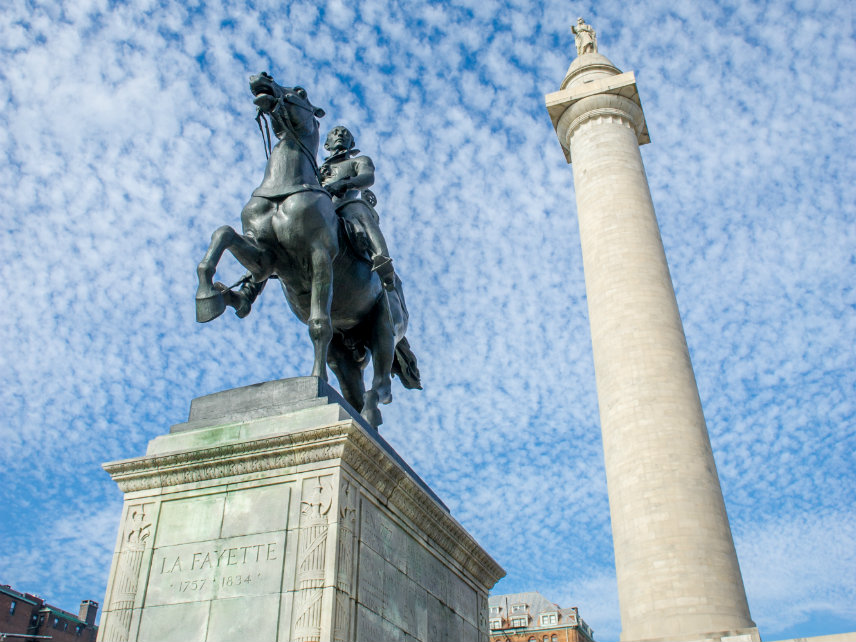Can You Tell The Difference Between Confederate Leaders and George Washington? Baltimore Officials Can.
Why can't the president?

In downtown Baltimore—appropriately enough, in the Mount Vernon Place neighborhood—there is a huge monument to George Washington. It's been there since the 1820s, predating by nearly 30 years the taller, better known Washington Monument that is the centerpiece of the National Mall in Washington, D.C.
On Wednesday morning, Baltimore's Washington Monument still stands, a proud testament to the man who metaphorically fathered his country and fought for the cause of freedom. Elsewhere in Baltimore, though, statues and monuments to men who fought against that country and that cause are nowhere to be found.
That's because the Baltimore City Council unanimously passed a resolution earlier this week calling for the immediate removal of the city's Confederate monuments. Mayor Catherine Pugh signed the resolution and, The Baltimore Sun reports, looked on as city work crews by 5 am today removed four monuments—one for generals Robert E. Lee and Thomas "Stonewall" Jackson, one for "Confederate soldiers and sailors," and one for "Confederate women." The fourth was for Supreme Court Chief Justice Roger B. Taney, a Maryland native and author of the majority opinion in the infamous Dred Scott case that determined former slaves could not become U.S. citizens.
"It's done," Pugh told the Sun on Wednesday morning. "They needed to come down. My concern is for the safety and security of our people. We moved as quickly as we could."
And by taking swift, decisive action to remove Confederate monuments while leaving historical markers like the Washington Monument in place, Baltimore offers a primer on the nonsensical slippery slope argument offered by defenders of the Confederate monuments—an argument that President Donald Trump employed during a freewheeling press conference on Tuesday afternoon.
Asked about violence that broke-out in Charlottesville, Virginia, last weekend after a group of white nationalists, neo-Nazis, and Confederate sympathizes gathered to protest the planned removal of a statue honoring Lee, Trump offered that taking down one monument would equate to taking down all monuments.
"So this week, it is Robert E. Lee. I noticed that Stonewall Jackson is coming down," Trump said. "I wonder, is it George Washington next week? And is it Thomas Jefferson the week after? You know, you really do have to ask yourself, where does it stop?"
It stops….where it stops. No one action determines that any other action must take place. Reasonable people can clearly differentiate between the legacies of men who fought against the United States in order to maintain an economic system built on the institution of human slavery and men honored as founders of the nation, be they flawed men who owned slaves themselves.
Erasing that difference in order to defend the men who led the fight for cecession does a disservice to historical fact and to the ideals championed by Washington and the rest of the founders.
Even within the realm of Confederate monuments, there are degrees of difference. I tend to agree with my colleague Ron Bailey that memorials to Confederate dead or Confederate soldiers should be viewed through a different lens than those to specific Confederate leaders like Lee or Jackson or Jefferson Davis. Even if they died for a wrongful cause, all communties should have a right to mourn their dead and remember the awful cost of war.
Memorials to misguided leaders—many erected for political purposes during the Jim Crow era—are a different matter. In that sense, perhaps Baltimore went too far removing the memorials to the Confederate soldiers and sailors, and to women who helped the Confederate cause.
Still, even as those distinctions were (perhaps erroneously) wiped away, it's crucial to note that the distinction between Confederate monuments and monuments to slaveholding Founding Fathers remains. Conflating the removal of Confederate monuments with a broader attempt to erase history is inaccurate both philosophically and empirically.
Look no further than Mount Vernon Place in Baltimore. On Tuesday, the monument to Justice Taney shared the square with the monument to Washington (and another to the Marquis de Lafayette, the revolution-era French general). Today, only Washington and Lafayette remain.
Reasonable people can disagree about whether the Confederate monuments should stay in place as way to acknowledge the complicated history and complex individuals they represent.
But it is wrong to argue, as Trump and others have, that monuments to Lee and Jackson exist on the same moral plane as monuments to Washington and Jefferson. They are fundamentally different, and whether you agree with what Baltimore did on Tuesday night or not, the city's actions demonstrate the difference.


Show Comments (438)